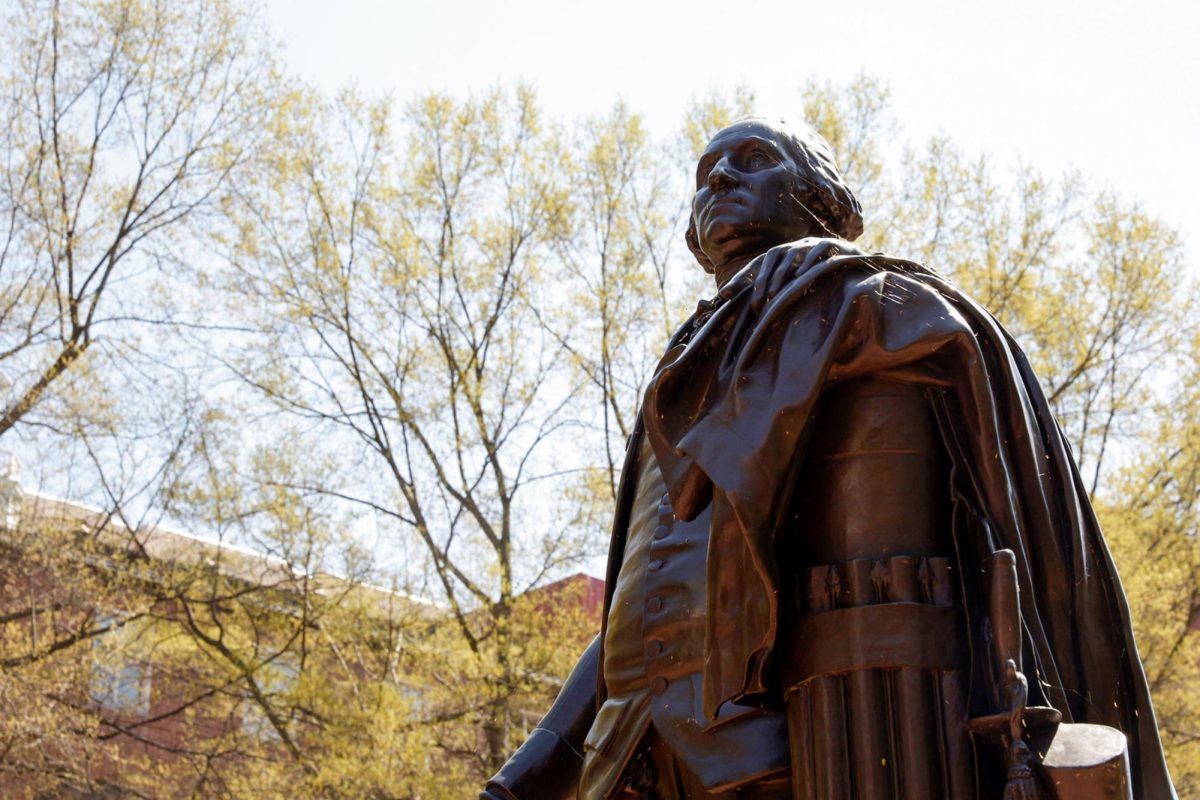At 6:26 p.m., the first tone of the night dispatches the five-person EMeRG crew.
The “D shift” begins, lasting from 6 p.m. to 8 a.m. – a period of waiting punctuated by five calls Friday.
A female student with difficulty breathing set the team into a familiar motion – lacing up their bulky combat-style boots, grabbing radios and slinging heavy medical bags over their shoulders. With sirens blaring, they maneuver their 10-year-old ambulance through the rush hour traffic from the EMeRG office to Lafayette Hall.
After arriving on scene, the team took the patient’s vitals as she explained feeling light-headed and tingly after using her inhaler. Based on the patient’s presentation, Alexandra Coward, a senior and the night’s crew chief, advised the patient to monitor her symptoms and follow up with her doctor.

“We are the people who get called in an emergency. No emergency can be our emergency. We have to be the voice of reason, the voice of calm, the voice of everything,” Coward said. “When everyone around us is in their most vulnerable position, in a state of chaos, we have to be the center of the storm, all the time.”
Because of Health Insurance Portability and Accountability Act privacy rules, The Hatchet agreed to identify patients only by their gender and location before joining the emergency medical response team on the ride-along.
EMeRG is a student-based all-volunteer EMS team, headed by one paid administrative coordinator employed by the University. The organization responds to dispatches 24 hours a day throughout the academic year. They are licensed to provide basic life support to all patients.
The patients that are transported to a hospital for any reason save themselves the cost of a District ambulance ride, which can total $500 to $1,000.
Every Friday evening the team holds Continuing Medical Education classes, known as CMEs – just one of the endless acronyms the team spits out in nearly every sentence.
This week the students discussed OB/GYN treatment, tackling topics like how to quantify vaginal bleeding, what to do if dispatched to a patient about to give birth and how to identify the telltale “shuffle” of pelvic inflammatory disease.
As the night progresses, the overnight team, made up of supervisor Kush Das, Coward, attendants Kirsten Hartwick, Jordan Zaid and Mark Mallozzi, waits until their next call. This time, a male patient at Gelman Library has a small laceration on his hand.
EMeRG arrived on the scene in minutes, moving just a block from their part-living room, part-supply storage, part-bedroom second floor office space. Their average response time for any call is 3.5 minutes, while the average call response time for D.C. Fire and EMS for Foggy Bottom is 12 minutes.
It wasn’t until 2:21 a.m. when the team gets their first alcohol-related dispatch. Despite a reputation as the on-campus alcohol police – a student nickname the crew lamentably acknowledges – their calls are only 30 percent alcohol-related.
The reputation rings untrue as the University Police Department, not EMeRG, makes the final call when deciding to send a student to the hospital for alcohol-related incidents. The members of EMeRG said fighting this reputation is one of the toughest parts of the job.
Das, who was an EMT and firefighter in New Jersey, remembers the warm welcomes he received when wearing his uniform around town. Here, Das gets the occasional stare from students and rarely hears a thank you.
The “GW EMS” insignia which emblazes their uniform is a badge of pride amongst the team but it also makes them a recognizable, often unpopular, group on campus. Das laughs remembering the night an inebriated patient took a swing at a crew member.
Friday was no different. At their post-2 a.m. call, a clearly intoxicated patient who vomited in Mitchell Hall cried and begged the attendants not to transport her. Based on University policy, any student, no matter their age, found and assessed as legally intoxicated on campus must be transported to the hospital.
The toughest calls can be sexual assault cases, especially for the female members of the crew as they become the liaison between the male members and a female patient in distress.
During “snowmaggedon” Coward remembers being on her fourth call as an EMeRG member, dispatched to a potential sexual assault patient. She was not only the “newbie,” but also the only female on the crew that night. She remembers being nervous and unsure, worried about her actions. Das recalls that the patient, already fed up with the male members, would only communicate with Coward, despite her being the least experienced on the scene.
“That’s part of our job. We get stuck in situations we aren’t ready for all the time, and you have to just rise to the challenge, step up to the plate and keep in mind what’s best for you, what’s best for your crew, what’s best for your patient and just figure out a way to handle it,” Coward said.
To advance within the ranks, moving up from probationary members to attendant to field training officers to the top position of supervisor – a position only five members have attained – members must gain multiple endorsements and evaluations, pass oral, written and practical exams, work special events, gain driver status as well as gain hundreds of hours of on-duty experience at each position. Just moving one step from probationary member to attendant requires 200 hours.
Coward is now a crew chief and field training officer, knowledgeably directing and instructing attendants and first semester “probationary” members on how to file paper work, communicate with a patient, assess treatment and act calmly in the eye of any storm.
After a lengthy, interview-heavy application process and before starting the first strictly probationary semester, new members are required to attend a five to seven-day long “academy,” as well as monthly and weekly classes and trainings.
“The training is what keeps this place going, year after year,” Das said.
Every shift is a learning experience, both Coward and Das explain. No matter what happens on a call, a crew chief leads a debriefing session at the end, going over what was good, what was bad and how to improve as a team. Each crew chief has his or her own style of leading a debriefing after a call, choosing to either huddle in the back of the ambulance or in their second story office, but the constant post-call assessment is necessary for advancing, Coward explains.
“We make sure every call is run perfectly, and if it’s not run perfectly, we drill everyone as to how it can be run better next time,” Coward said.
As a supervisor, Das delegates, dispatching his crew, assessing and utilizing their skills, sometimes managing double calls and making sure that while he learns, his team learns too.
He willingly admits they can always do better.
“You are only as good as the sum of your subordinates,” Das said.
The job is exhausting, and shifts can be frustrating, Coward and Das said. But during the overnight shift, sleep can be a limited and relished commodity. The crew has the option of sleeping on bunk beds or broken-in couches, but at the sound of a tone, they must be ready, alert and in the mindset of an EMS provider.
“We can practice all we want – we can do scenarios until we are exhausted – but we can’t reenact the stress or the adrenaline pump that you get from hearing the tones go off and hearing the dispatch,” Coward said. “We just absolutely can’t recreate them.”
They spend a majority of their shifts hanging out, watching movies or just talking, Coward said, but the other portion is spent in high-stress, consistently rewarding scenarios.
“There is nothing I do that I like as much as this,” Das said.







